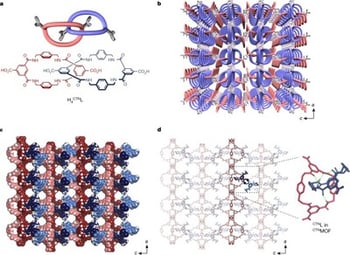PRESS RELEASE
- Research
- 2021
An elastic metal–organic crystal with a densely catenated backbone
Authors
Wenjing Meng, Shun Kondo, Takuji Ito, Kazuki Komatsu, Jenny Pirillo, Yuh Hijikata, Yuichi Ikuhara, Takuzo Aida & Hiroshi Sato
Abstract
What particular mechanical properties can be expected for materials composed of interlocked backbones has been a long-standing issue in materials science since the first reports on polycatenane and polyrotaxane in the 1970s1,2,3. Here we report a three-dimensional porous metal–organic crystal, which is exceptional in that its warps and wefts are connected only by catenation. This porous crystal is composed of a tetragonal lattice and dynamically changes its geometry upon guest molecule release, uptake and exchange, and also upon temperature variation even in a low temperature range. We indented4 the crystal along its a/b axes and obtained the Young’s moduli of 1.77 ± 0.16 GPa in N,N-dimethylformamide and 1.63 ± 0.13 GPa in tetrahydrofuran, which are the lowest among those reported so far for porous metal–organic crystals5. To our surprise, hydrostatic compression showed that this elastic porous crystal was the most deformable along its c axis, where 5% contraction occurred without structural deterioration upon compression up to 0.88 GPa. The crystal structure obtained at 0.46 GPa showed that the catenated macrocycles move translationally upon contraction. We anticipate our mechanically interlocked molecule-based design to be a starting point for the development of porous materials with exotic mechanical properties. For example, squeezable porous crystals that may address an essential difficulty in realizing both high abilities of guest uptake and release are on the horizon.

【References】
1.Agam, G., Graiver, D. & Zilkha, A. Studies on the formation of topological isomers by statistical methods. J. Am. Chem. Soc. 98, 5206–5214 (1976).
2.Ogata, N., Sanui, K. & Wada, J. Novel synthesis of inclusion polyamides. J. Polym. Sci. Polym. Lett. Ed. 14, 459−462 (1976).
3.Raymo, F. M. & Stoddart, J. F. Interlocked macromolecules. Chem. Rev. 99, 1643−1663 (1999).
4.Bhushan, B. & Li, X. A review of nanoindentation continuous stiffness measurement technique and its applications. Mater. Charact. 48, 11–36 (2002).
5.Tan, J. C. & Cheetham, A. K. Mechanical properties of hybrid inorganic–organic framework materials: establishing fundamental structure–property relationships. Chem. Soc. Rev. 40, 1059–1080 (2011).

